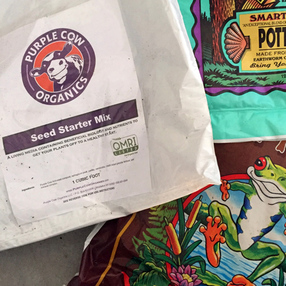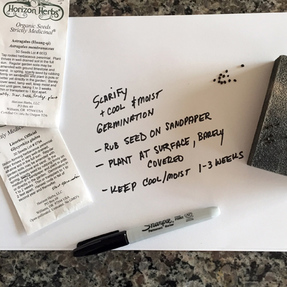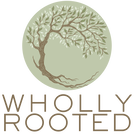|
The flu has occupied most of my time for the past few weeks. It worked its way though much of the household, leaving me little time to focus on seedlings or garden planning. Luckily, while an exacting schedule is important for commercial growers, for the home grower we have a lot of flexibility. I appreciate my box system when I don't have a lot of time - I go to the envelope, grab a pre-filled seed tray, and go go go.  Speaking of pre-filled. I like to make my own seed starting mix from local organic seed starting blend, a potting mix with kelp and compost, worm castings, and a sterile type of renewable coir mix. It is important to me that our potting soils, composts, and seed starting mixes don't contain certain our allergens. I am happy that when I can't find the methods or ingredients on a package or website that my local garden/hydroponics store is always happy to call and ask for me. Because of that, I tend to stick with only a few brands that I know have good practices, pay close attention to all that goes into their mix and their sources, and use hot composting methods where things are fully broken down where applicable. I also like local when possible. Because of that I tend to buy all of my soil/compost/fertilizer from just one or two local places where I know exactly what I am getting. You can find recipes for seed starting mixes online that will best suit your climate and seedlings. I start with a large storage bin and mix all of my seed starting medium in that right in my garage. I can store it there and it is easy to step out and fill another tray. To keep everything streamlined I really like pre-filling a bunch of trays so I can grab and go. Less mess and less time. As my big bin of seed starting mix gets low, I make another batch. Right up into plant out time where I use a little different blend to fill my pots and containers. Most people who garden know how easy it is to start tomatoes, cucumbers, basil, and peas. They have been cultivated to where we can rely on good germination and pretty easy starting. Where I see people get unsure is often when you go into medicinal herbs, prairie or native plants, and more exotic or uncommon flowers and herbs. The packets talk about scarifying, stratification, scarification, and cold dormancy or extended germination. It used to seem confusing, but when I started categorizing my seeds in my box system, categorizing them into the basic types of germination wasn't too hard. I don't like to go overboard, I just like things that work well, simply. These methods may seem picky and delicate and time-consuming, but if you break it down it is pretty simple. And the bonus is you can grow some pretty cool plants you would never find in a garden center. These native plants, herbs, and flowers are also often those which are great for pollinators, attracting beneficials to your garden. Most general seed packets will tell you to when to plant in ground, or how many weeks before last frost to start your seedlings and when to plant out. Natives, medicinal, prairie, and many more exotic plants may often require a bit more care to get them going. These seeds also often come in packets with very few seeds, meaning you want a high germination rate/success rate. There are a few common techniques specified on these seed packets, and while they may seem like a lot, it really only takes a few minutes to get things rolling.  Cold stratification means the seeds like a feeling of winter before they are ready to go. Putting the seed packs into the refrigerator for a few week gives them a kickstart. The easiest way to do this is by putting them in a baggie and labeling in/out dates for your fridge.  Another cold stratification is the moist type. I put these in a baggie in my fridge for a few weeks as well, but in a moist paper towel in the baggie, not in the packet. Be sure to note the in/out date on the bag. Some of these seeds like to get a scratch on the sandpaper first too.  Some seeds, like lavender, like cold stratification in a medium such as sand or soil. For these, I put them in a baggie in the fridge at the same time as the rest, I just put them in some potting soil in the baggie and note in/out date.  Scarification is when a seed needs to be scratched or penetrated a bit to begin the germination. A cool and moist scarification germination just means rub the seed on sandpaper, plant at the surface and lightly cover with soil, and keep cool and moist for 1-3 weeks until it germinates. Then treat it as you do the other seedlings until planting out.  There can also be warm germinators which needs soaking and scarification to germinate. For these, give a quick nick or rub with sandpaper, soak in warm water overnight, and plant, lightly covered in soil. Keep warm and moist until germination occurs, and then treat as you do other seedlings.  That may seem like a lot to do, but in reality each type only takes a few minutes. The rest of the time is watering or waiting. I like to print out blank monthly calendars from March through June and keep it in my seed box. I note how each week by week number until last frost date, so it coordinates with all of the folders with seeds. I also can easily write down when to pull the baggies out of the fridge and plant them, etc. It makes it pretty foolproof. I like that I have basically a noted calendar of each year that I can look back on next year too. I'm feeling the effects of March. It is windy and cold, we are cooped up (with one kid after another sick). Everything is muddy over frozen so no hiking or garden work can be done yet. I am definitely stir-crazy. I know seed starting and planning the garden is one of the things that actually gets me through to spring here in Wisconsin. On the one hand I'm starting seeds!!!! On the other hand we still have 3 MONTHS before our CSA even begins. Each little tray of soil and seeds is a lifeline to warm sunny days and green grass and hours spent outside. So even though some of the seeds require a little more care and attention to get going than some of the more common vegetables and herbs, they are worth every moment in potential. I can see bees buzzing, hummingbirds swooping, smell the fragrance as the sun sets and my kids rock in the hammock. It is all good.
Speaking of good, we are picking up our mason bees and beneficial insects this week. Spring really is coming! More seed starting and greenhouse assembling to come. :)
2 Comments
Your comment will be posted after it is approved.
Leave a Reply. |
denise cusackI am a certified aromatherapist, clinical herbalist, permaculture designer, organic gardener, plant conservationist, photographer, writer, designer, artist, nature lover, health justice activist, whole foods maker, and mother of two young adults in south central Wisconsin. Categories
All
©2007-23 Denise Cusack, all photos and text. Feel free to share my posts on FB or Twitter or online media or pin on Pinterest (thank you!), but please keep the links back to my website intact (meaning please do not take or copy my images off of this website and share them unattributed or without linking back here or use them without permission). Thank you! :)
|
